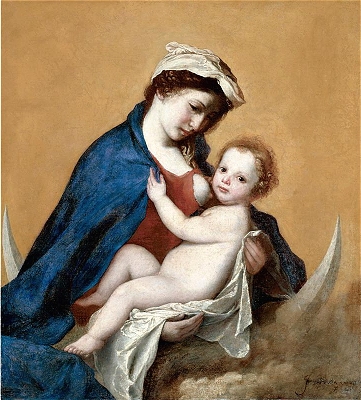MADONNA AND CHILD
Jusepe de Ribera
Spanish, about 1590-1652
SN 334, Oil on canvas, 1643From "The Pages"
ARTIST:
De Ribera was born in Valencia, son of a shoemaker. However, when hardly out of his teens
he was off to Italy, so that all of his known career is outside of Spain. Although he
became one of the most important painters in Europe, he remains an elusive, shadowy
figure.
He attended the Accademia de St Luca in Rome in 1613; he was much influenced by
Caravaggio, altho’ when the latter died in 1610, Ribera was barely 20. After visiting
Parma, Bologna, & Rome, he settled in Spanish-ruled Naples in 1616.
He was an accomplished printmaker, inspiring followers who had never seen his paintings. A
prolific & accomplished draftsman, he would sketch for the next day’s painting
while engaging visiting clients in conversation. Soon he was filling commissions for the
Italian church, expatriate Spanish grandees, & supplying |
|
 |
Philip IV with many paintings; he became the most famous artist in Naples. The Italians
called him “Lo Spagnoletto” – “the little Spaniard.”
In 1626 he went to Rome to receive a Vatican Order of Nobility, & was awarded a
similar honor in Portugal. He oversaw a large workshop & his painting exerted an
immense influence on Velasquez and Zurbar n, among others.
He married another highly-regarded artist’s daughter. A violent man, he was reputedly
involved in many escapades; it has been said that he belonged to a kind of painters’
Mafia in Naples, which struck terror into the hearts of artists who weren’t members;
the nasty tricks included mixing dirt into the paint pigments of his rivals, & sending
them poison-pen letters.
SUBJECT:
Many of Ribera’s paintings exploited moments of high religious drama, gruesome
martyrdom, the Crucifixion – all rendered with harsh realism & exact observation.
His models were chosen from filthy Neopolitan streets, & his depictions of violence
& the grinding poverty in Naples were terrifying. “When Ribera’s figures
smile, they reveal the worst teeth in Western art; a small gust of caries blows from the
museum walls.” (Time, 10/12/92)
But toward the end of his life, Ribera turned away from the blood & suffering he had
portrayed so brutally, becoming more reverent. The Madonna nursing the Christ child was a
popular theme, & Ribera’s Madonnas are wistful beauties.
PAINTING;
Here the Madonna is portrayed as a loving mother, gravely holding her sleepy, naked Child
in her arms. She gazes down at her Child with love - and a hint of sadness at what is to
come. And unlike many representations of the Christ child, this one brings us a beautiful
Infant!
Ribera has included the symbolic crescent moon on which they rest. This type of image
referred to the Immaculate Conception, & promoted the doctrine that Mary was free from
original sin. Often an attribute of the Virgin, the moon suggests that Mary is above its
transitory phases; she is eternal. (Revelations 12:1, reads: “a woman clothed with
the sun, and the moon….under her feet…”) Ribera, however, gives us a real,
down-to-earth young woman in a celestial setting.
Ribera used a rich impasto and fast brushwork to build a surface that achieves an exciting
life of his own .
Additional Bibliography:
Metropolitan Museum of Art Catalog Exhibition, Sept 18-Nov 29, 1992.
Wall Street Journal, Arts & Leisure section, ) Oct 28, 1992.
ringlingdocents.org
|